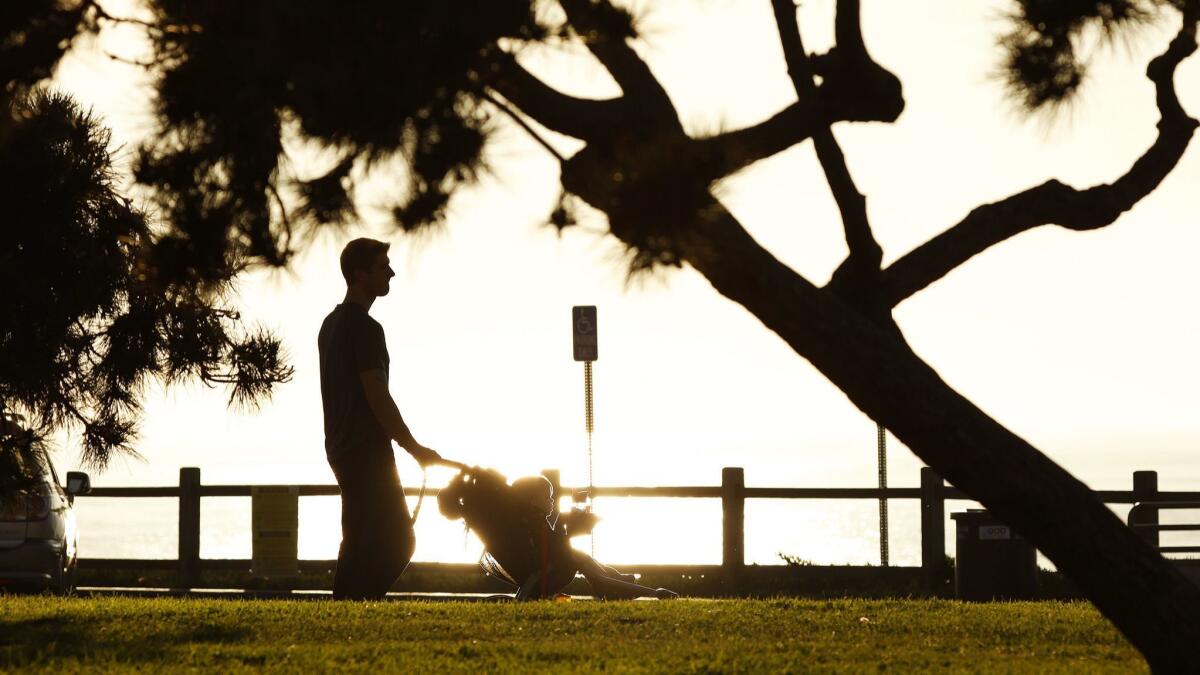Endorsement: Vote yes on Proposition 7 to force another look at daylight saving time

- Share via
In a few weeks, most Americans will turn their clocks back one hour as daylight saving time ends and standard time begins. Or is that one hour forward?
It’s the former, but we had to look it up to be sure. Keeping the time changes straight can be a challenge, despite the fact that we “spring forward” and “fall back” every year — and have done so for decades. It’s also a challenge to adjust our internal clocks to suddenly having sunlight at different times of the day than our brains are used to.
Actually, it’s more than just a challenge. Studies have found that this semi-annual time shift disrupts the human circadian cycle. In fact, heart attacks increase in the days immediately following the clock adjustment, researchers have found, perhaps because the time change disrupts people’s sleep.
So why don’t we stop observing this pointless tradition? That’s the pitch behind Proposition 7 on the Nov. 6 ballot, which would set the stage for Californians to move to daylight saving time year round and never have to make the November jump into late-afternoon darkness again.
There’s a growing national and even global movement to dump the time change.
It’s not exactly that simple, however. If voters approve the measure, it would merely make a change possible by repealing parts of a nearly 70-year-old state law and giving the California Legislature permission to approve a shift to year-round daylight saving time by a two-thirds vote (staying on standard time year round would not be an option). Even so, California couldn’t make the time switch without permission from Congress. Federal law allows states to stop observing daylight saving time, but not to make it permanent.
In other words, Proposition 7 won’t stop the clock-changing; it would just allow the discussion to continue about the merits of doing so, as well as making the procedural changes needed to allow a future shift to permanent daylight saving time. It’s a debate worth having, and for that reason we urge voters to say “yes” on this measure.
Changing the clocks twice a year is hardly among the pressing issues facing California in the era of Donald Trump and global warming. But it is a disruptive and pointless practice that continues mostly because we’re used to it. Daylight saving time was introduced during World War II at least in part because later summer sunsets were supposed to cut energy use, but those reductions never materialized. And we’ve kept switching back to standard time in the fall so that children wouldn’t be going to school in the dark on so many mornings, but there’s no conclusive evidence that changing the clocks makes them safer or that not doing so would put them in harm’s way.
(Many of us grew up hearing that daylight saving time was created to benefit farmers. Yet in California at least, farmers were fiercely opposed to the ballot measure pushed by chambers of commerce in 1949 that started the state’s clock-changing tradition.)
Enter the Fray: First takes on the news of the minute from L.A. Times Opinion »
Nevertheless, California shouldn’t strike out on its own on this issue, which is why The Times’ editorial board opposed an earlier version of the bill by Assemblyman Kansen Chu (D-San Jose) that put this question on the 2018 ballot. “Better to start a national conversation about whether the practice still makes sense than to find ourselves out-of-whack with other states in our time zone,” we wrote in 2016. All U.S. states except Arizona and Hawaii observe the spring and fall switch between daylight saving and standard time.
Since then, however, a national conversation has gotten started. In fact, there’s a growing national and even global movement to dump the time change. Lawmakers in more than a dozen U.S. states have considered legislation to remain on permanent daylight saving time, though only Florida has voted to do so. The European Union will stop changing its clocks next year, allowing its member countries to decide whether to adopt permanent daylight savings.
Obviously, the best way to proceed is with a nationwide standard, set by legislation such as the Sunshine Protection Act by U.S. Sen. Marco Rubio (R-Fla.) that would make daylight saving time permanent across the nation. The inconvenience of a meaningless tradition is far better than the confusion that would come from states observing a mishmash of different times. In fact, the lack of a common approach to daylight saving time led Congress to adopt the Uniform Time Act of 1966, which set the dates when clocks moved back and forth.
Passing Proposition 7 wouldn’t necessarily make California an outlier, but would allow the state the flexibility in the future to join a national movement to adopt permanent daylight saving time, as well as signaling to Congress that the time is up for this clock-changing nonsense.
Follow the Opinion section on Twitter @latimesopinion and Facebook
UPDATES:
An earlier version of this article said that a study found heart attacks increase after the fall clock change. The increase happens after the spring change.
More to Read
A cure for the common opinion
Get thought-provoking perspectives with our weekly newsletter.
You may occasionally receive promotional content from the Los Angeles Times.










